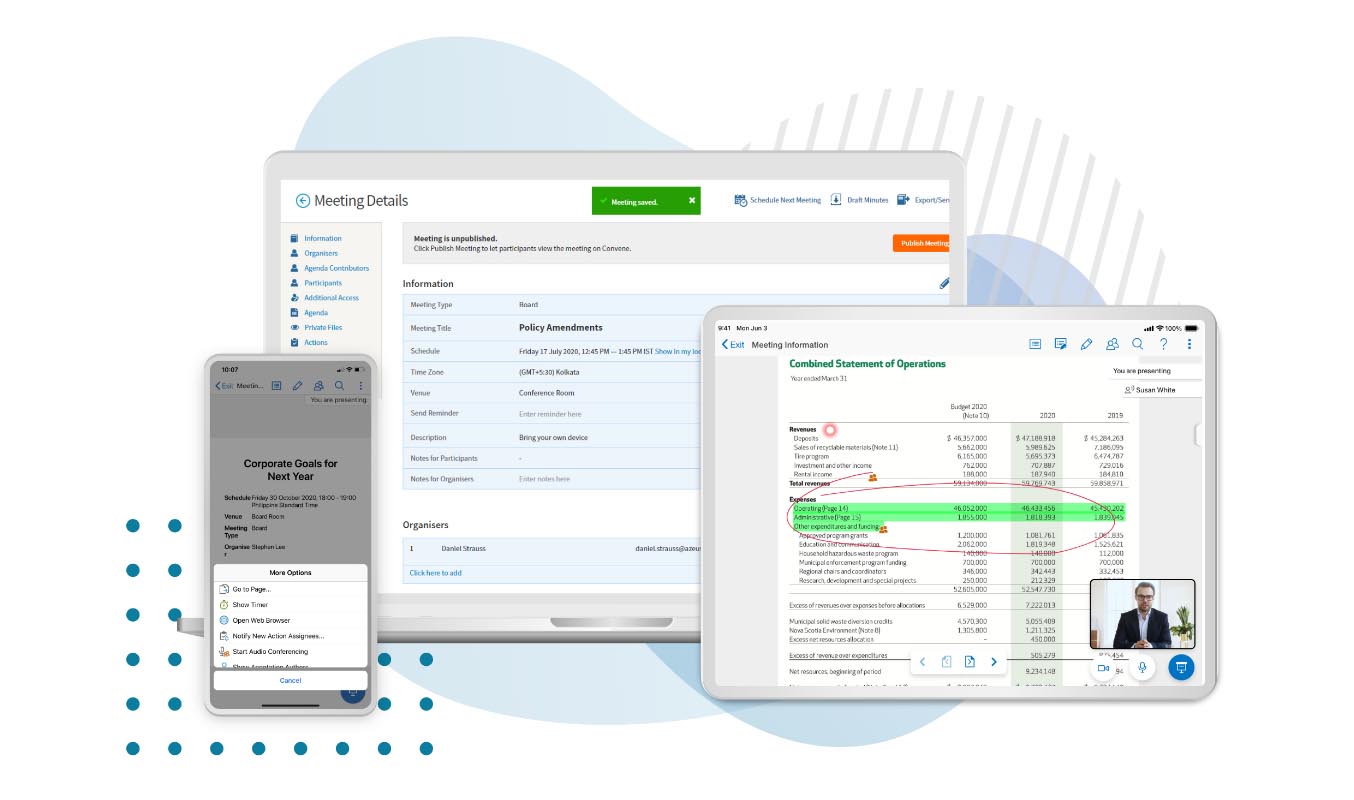‘Do we have a quorum?’ This is probably one of the frequently asked questions in a board meeting. Quorum is derived from Latin, which means “of whom”. The word is originally used to refer to justices whose presence in English counties was required for business transactions.
Today, the quorum is mainly used in corporations and nonprofit organizations for conducting meetings and making overall decisions to empower governance and achieve their goals. It sets a protocol on the demographic of the decision-makers or the board directors to make the proceedings valid. Such a definition may sound simple, but it gets complicated. Read on to know more about quorum for board meeting — particularly, constituting and reaching one.
What is a quorum?
According to Robert’s Rules of Order, quorum refers to the minimum number of present members to call a meeting or conduct business. In the board’s case, the quorum serves as the acceptable number of directors who have a significant stake in the company and are present to make the proceedings of a meeting valid under the corporate charter.
Quorums are essential in ensuring that crucial decisions or changes are made from the sufficient representation of the board. These can prevent severe consequences of minority rule and miscalculated risks.
Why is having a quorum important?
A quorum for board meeting is essential in safeguarding the integrity of the decision-making process. It should represent the majority number of board members present in the approval or decision-making roles.
When a quorum is not present, certain actions become impossible to carry out. For instance, members cannot provide unanimous consent or issue a notice for another meeting. In both scenarios, the lack of a quorum prevents the attainment of a sufficient number of members required to achieve a majority.
It makes no sense when board decisions are not balanced and well-informed, as this may just result in overturns by the subsequent meeting where more members are present. Perfect attendance at every board meeting is rare, so the quorum ensures enough members are present for a reasonable majority vote.
Setting an acceptable minimum number of members to be involved in decision-making protects the board and the organization from the risk of misrepresenting the whole board — making decisions that may not entirely benefit the entire organization and its stakeholders.
What is considered a quorum for a meeting?
In most companies, the bylaws establish the policies for a quorum. But in the absence of defined rules, a simple majority on attendance is what constitutes a quorum. The generic formula for determining the “majority” as a quorum is one-half plus one of the total number of directors. For instance, if there are ten board directors, a quorum from the majority is equal to six board directors who are present in attendance.
In the Canadian corporate subsidiary, typically, a majority of directors must be present during a board meeting. Some jurisdictions may require 25% resident Canadian directors. The same general guidelines apply also in the United States, with an alternative to all the directors executing written resolutions.
What actions to take when a quorum is lost?

As the safeguard of unbiased and well-represented decisions, a quorum is an essential protocol for board meetings. However, it is possible to “lose” it if a member needs to leave. Here are the steps that can be taken when you lose a quorum:
- Adjust the meeting schedule — In hopes of fixing the quorum, existing attendees can adjust the adjournment time. However, this can mean delays in the established schedule of each member.
- Take a recess — When a quorum has been lost mid-meeting due to members taking personal breaks, remaining members can opt for a meeting pause to round up more members and meet the quorum.
- Adjourn the meeting — This can be done for meetings that do not require time-based actions, such as regular budget meetings. The remaining attendees can adjourn the meeting and push the defined agenda at the next meeting.
- Enact a privileged motion — Depending on the type and agenda of the meeting, members may demand to proceed with the regular order of business, excluding actions that need a quorum.
Considering the crucial role of a quorum in a board’s decision-making process, the loss of the quorum and the next steps must be documented in the meeting minutes.
Tips on How to Reach a Quorum
Promoting a streamlined and efficient decision-making process is most possible when a quorum is met throughout the meeting — when all agenda items that should be voted on can proceed. To make valid actions and decisions, here are several steps and tips for members, corporate secretaries, and administrators to reach the majority or quorum.
- Assess meeting times and days of members — Push out a survey or poll on the days and times that best work for members to attend a meeting. You can work with board administrators and executive assistants on this to communicate upcoming and recurring activities.
- Set recurring meeting times — Once the meeting time has been established, build this as the regular board meeting time. For instance, if the board meets every first Tuesday of the month, book this time in advance and recurringly.
- Send sufficient notice to the members — If meeting invites are not enough to prompt the attendees, consider leveraging email calendars and personal reminders in advance of the meeting day. Evaluate poor attendance — Some reasons why members are reluctant to attend are the overwhelming number of meetings, or that the agenda items are not relevant and productive. If possible, curtail the number of meetings and assess the agenda items and expected meeting outcomes. Encourage attendance by directly communicating its impact on organizational decisions and governance.
- Offer flexible options for attendance and participation — Following bylaws, some organizations may consider phone or video conferencing as eligible attendance (now being escalated with the emergence of virtual and hybrid meetings). With members attending virtually, they can still subscribe to the quorum. Board technologies, like board meeting apps, are designed to conduct virtual meetings via video conferencing and collaborative digital tools.
Inasmuch as the quorum is established in the bylaws, the governance committee must be able to track the attendance of the board members and review the defined quorum. While the currently stated quorum is backed up rationally, some red flags may show up and indicate a change—for growth and success. The best time to review such protocol is during strategic planning meetings, where goals, processes, and policies are evaluated and optimized.
Frequently Asked Questions about Quorum in a Board Meeting
When establishing a quorum, it is important to consider the impact and requirements of achieving one. Below is a compilation of the most common questions around meeting quorum.
Q: How many is a quorum?
By default, a quorum for board meeting constitutes the minimum number of voting members present at the meeting. Some organizations may require two-thirds of the members to be present in the meeting to achieve a quorum. For instance, what is a quorum of 5 board members? Generally, it should be 3 members. But some organizations may accept 2 or 4.
If there are prerequisites and special cases specific to the organization, it should be stated in the organization’s bylaws the percentage needed to reach a quorum. This number may vary as long as it is the agreed-upon majority of the voting members.
Q: What is an example of a quorum?
The number of board members needed to establish a quorum varies between governing bodies and the entity’s bylaws. The quorum may also depend on the structure of the board — corporations, non-profits, or university boards. Generally, 60% of the overall members are required to be present to reach a quorum.
An example of a quorum for a board meeting is the Northern Illinois University Board of Trustees Bylaws, which states, “Unless otherwise provided by law, the physical presence of five members of the board shall constitute a quorum. In cases of statewide emergency during which the physical presence of members is impractical, the board shall comply with the Illinois Open Meetings Act, as amended… A quorum of the board or committee must be physically present at the location of the meeting or simultaneously held videoconferencing at a publicly owned or leased Illinois location given public notice and public access.”
Q: What should you do when you regularly fail to reach a quorum?
When securing a quorum becomes a recurring issue, the idea of reducing the quorum requirement may arise. However, it may not be the best decision, as members may take attendance for granted. Merely maintaining a barely sufficient quorum is not enough. In light of this, here are some of the action steps to take:
- Prioritize attendance. This could be in the form of constitutional amendments to put consequences on absences.
- Raise the quorum requirement. It may sound contradicting, but setting a higher quorum can increase the moral pressure on members to attend the board meetings.
- Investigate the reasons for the low turnout. Look into the contributing factors of low attendance and address the issues. It is also recommended to make meetings more engaging and valuable.
Meet the Quorum with Board Management Software

Instituted to preserve meeting actions and decisions, quorum is one of the essential rules that must be honored at all times. To foster attendance and contribute to the quorum, board management software like Convene could be the solution you are looking for!
With its video conferencing integration and live meeting tools, collaboration during virtual and hybrid meetings won’t be a hassle anymore. Additionally, its Agenda Builder and Meeting Publisher feature makes it easier to schedule meetings and add relevant agenda items. No need to worry about too frequent and unproductive meetings. With Convene, meetings won’t be a bore anymore — encouraging better attendance and participation!
Discover the many features of Convene, and see how it can aid in designing your board meetings to be box-office and more effective.
Audrey is a Content Marketing Specialist at Convene, in charge of managing the production of quality content on the company’s website. A communication major keen on marketing, Audrey has been constantly seeking approaches to create tailored content—may it be about governance, digitalization, boards, or meetings—fit for the stakeholders. When not strategizing on the next ebook to produce, Audrey finds solitude in reading make-you-ugly-cry novels and listening to self-improvement podcasts.











